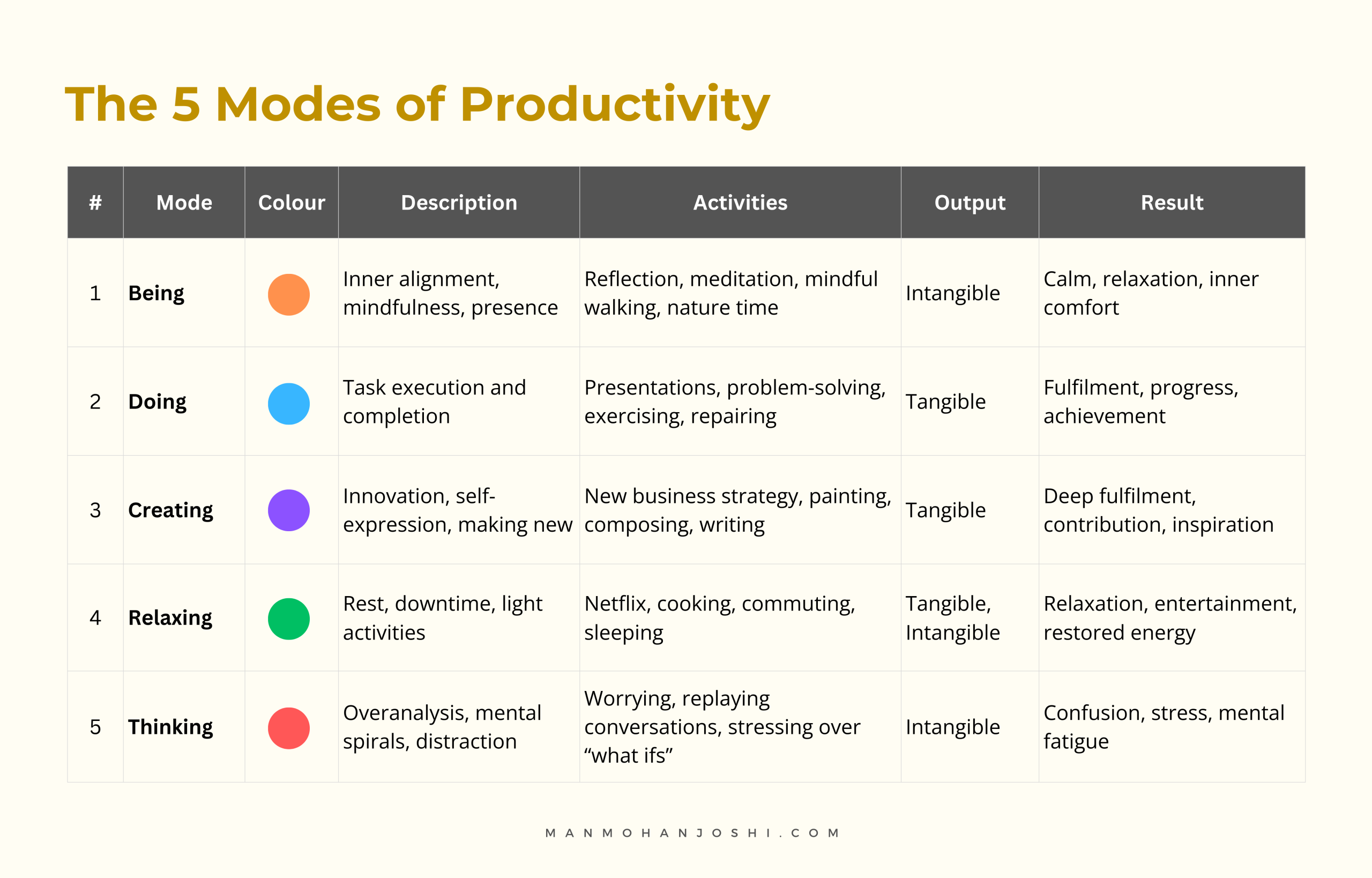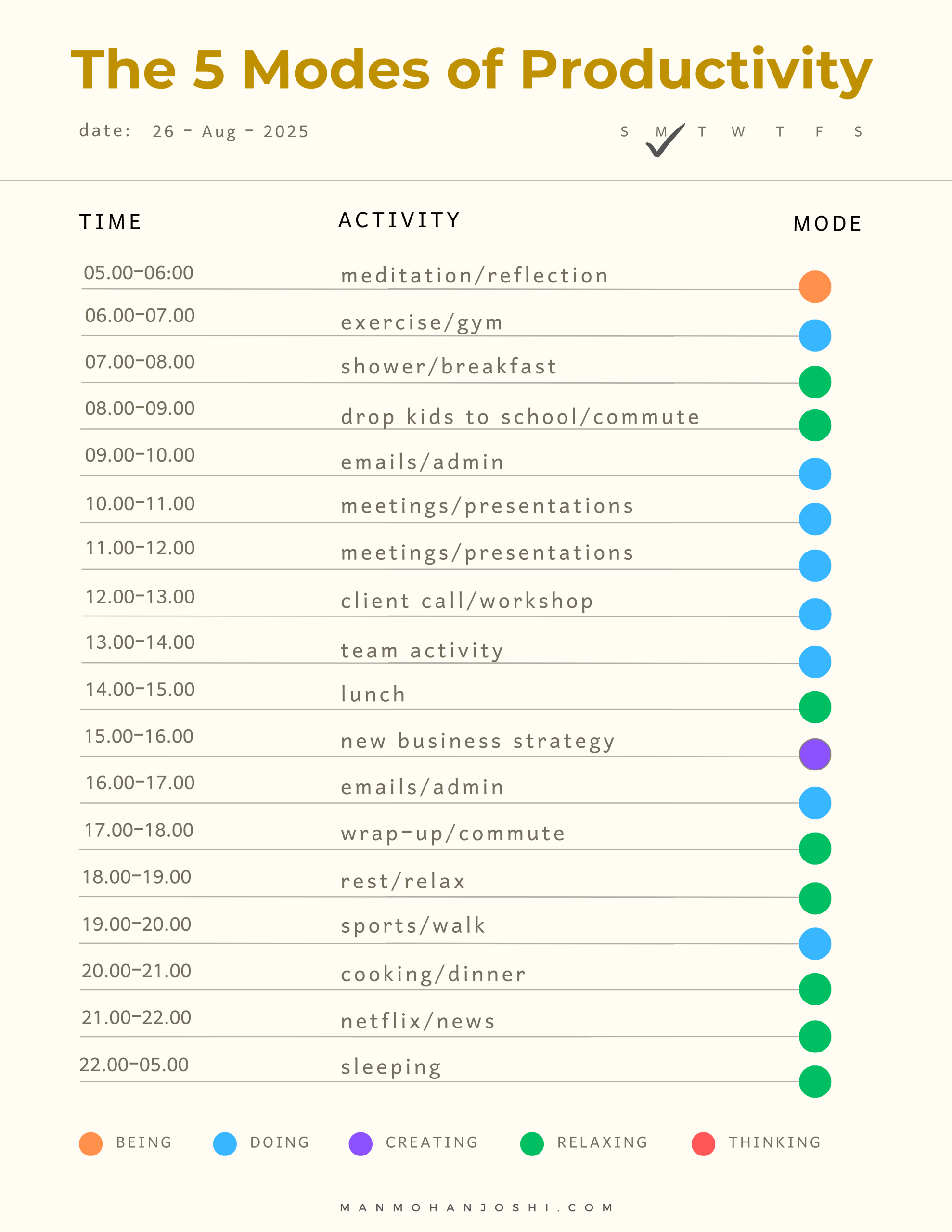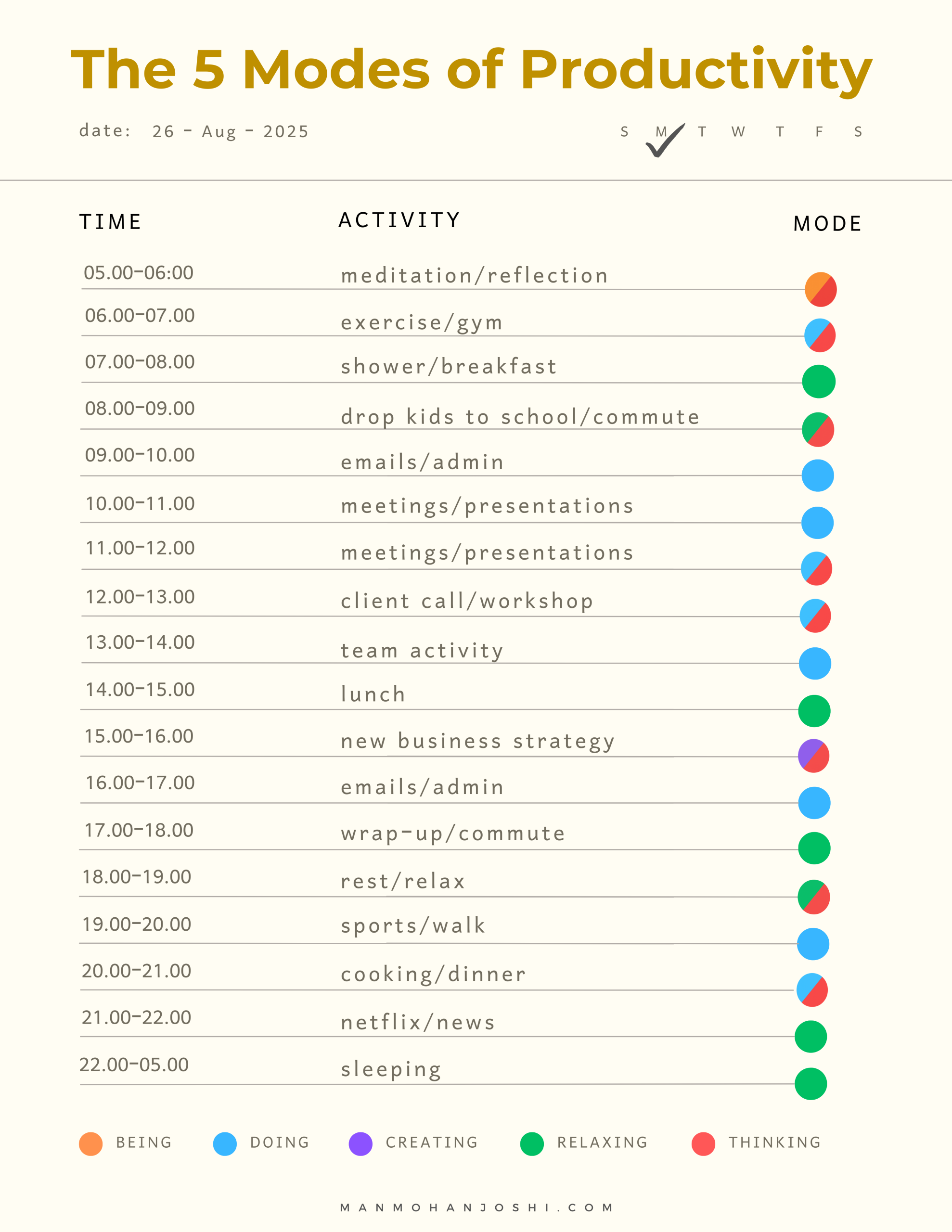We hear about productivity everywhere — job descriptions, performance reviews, self-help books, and the latest apps promising to 10x your output in 4 weeks.
But pause for a moment: what does being productive actually mean?
And more importantly: how can you track productivity in your own life?
To address these questions, I want to share a simple yet powerful framework: The 5 Modes of Productivity.
It helps you map where your time and energy really go each day — and gives you a clear lens to rebalance toward what matters most.
Let’s dive in.
Why Productivity Matters
For centuries, productivity has been a human obsession. Empires, corporations, and individuals alike have sought ways to get “more for less.”
In today’s world, where time feels scarce and demands are endless, productivity becomes not just a tool — but a compass to navigate modern life.
Truly productive people know how to use this concept to their advantage.
They harness productivity to:
-
- Do more in less time
- Think more clearly
- Free up energy for what matters
- Create space for rest and joy
- Feel happier and more fulfilled
Here’s the good news: productivity isn’t a gift you’re born with. It’s a skill you practice and a muscle you strengthen — through clarity and intention.
What is Productivity, Really?
The word productivity comes from the Latin word productivus — “able to produce.”
During the Industrial Revolution, productivity focused on mechanisation and mass production.
In the 20th century, it shifted to efficiency, task management, and output.
Today, it includes mental well-being, work-life balance, and growth — capturing both professional and personal dimensions.
At its core, productivity is how effectively you use time, energy, and resources on what truly matters.
Working long hours but creating little value isn’t productivity — it’s just being busy.
As McKinsey defines it:
Productivity measures the amount of value created for each hour that is worked in a society.
— McKinsey & Company
Notice the keyword here: value.
And that’s the heart of it. The ultimate goal of productivity is to create value — first for yourself, and then, at a higher scale, for others.
The 5 Modes of Productivity
I currently work a full-time 9–5 job in the management consulting industry. A few years ago, I started playing with the idea of creating a personal blog.
I’ve always loved reading about personal growth, well-being, and the like. Through my experiences in business, I came up with the idea of writing about how we can transform ourselves into greater versions of who we are.
But writing regularly is a big commitment, isn’t it?
I became curious:
Where can I find the time for writing?
These questions led me to review my daily schedule. I grabbed a pen and paper and started sketching out where my bandwidth was really going each day.
That’s when I realised something — I wasn’t simply “productive” or “unproductive.” My days naturally fell into different modes — from waking up, to commuting, to working, to winding down at night.
Viewed through the lens of productivity, each of these moments belonged to a different mode.
And that’s what led me to create a simple framework I call The 5 Modes of Productivity.
It helped me see the difference between actually doing meaningful work versus just staying busy planning or thinking about it.
Here are the five modes of productivity we all shift through in a given day:
1. Being
2. Doing
3. Creating
4. Relaxing
5. Thinking
For easier reference, I’m packing them into the following table with additional details.
Activities list the most common actions falling into that mode.
Output explains whether the mode produces something tangible (like a finished report or artwork) or intangible (clarity or energy).
Result highlights the outcome you’re left with after spending time in that mode — whether it’s progress, stress, fulfilment, or entertainment.

Illustration by the Author
Time for an Experiment — A Typical Day with the Modes
Now that you know the five productivity modes, let’s map them into your day.
From waking up to going to bed, you’ll naturally flow through these modes.
A typical day may look like this:

Illustration by the Author
At first glance, it might seem like a clean sequence — shifting neatly from one mode to another.
But wait — no Thinking mode in your day? That would be ideal, but it’s not reality.
Thinking mode sneaks in everywhere. It interrupts your presence, derails your actions, blocks your creativity, and even steals your rest.
(Important note: “Thinking mode” is different from the intentional thinking we use while Doing or Creating.)
That’s why the first step toward real change is simply noticing when and how often you slip into each mode.
So, in truth, a typical day looks more like the image below — the modes interwoven, with Thinking constantly interfering.
Of course, this will vary from person to person, depending on how consciously aware they are.
The real question becomes:
How self-aware are you? Can you even see it when it happens?

Illustration by the Author
How to Use This Framework
I’m currently working on a Productivity Tracker — based on the five productivity modes discussed above — to help you map your day and see where your time and energy are really going.
With these insights, you’ll be able to maximise productivity by:
-
- Rebalancing toward Being, Doing, and Creating
- Managing Relaxing
- Minimising unhelpful Thinking
Stay tuned for that.
In the meantime, take a moment to reflect:
-
- Which of the 5 productivity modes fills most of your day?
- Does it leave you fulfilled — or drained?
I’d love to hear your thoughts — drop them to my email: hello@manmohanjoshi.com
References:
McKinsey & Company. (2025, May 16). What is productivity? McKinsey & Company. https://www.mckinsey.com/featured-insights/mckinsey-explainers/what-is-productivity
ABOUT THE AUTHOR
Manmohan is a Writer and Creator. He writes about discovering potential and purpose–through understanding ourselves– and the transformation journey that unfolds afterwards.
His newsletter, The Infinite Pivot, shares ideas on how to break the status quo and pivot from being the current to a greater version of ourselves (The Infinite You) that makes an impact.
Learn more
Keep reading
-
A Memoir of Indian Childhood in the 90s
-
Design Your Life in 5-Year Blocks
-
I Tried Drawing Consciousness — Here’s How It Looks
-
Maslow’s Theory of Human Motivation in 10 Points
-
The 7 Things You Truly Need in Life
-
The Art of Living: 3 Simple Rules to Thrive in Life
-
These 5 Consciousness States Are Quietly Shaping Your Life
-
This 5-Step Process Can Transform Your Life
-
This Glacier Expedition In The Himalayas Taught Me About Purpose
-
This Symbol Helped Me Understand My True Self
Subscribe to my newsletter
The Infinite Pivot®
to keep receiving more thoughts like this, free.